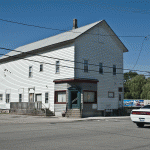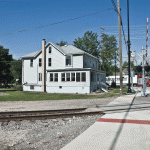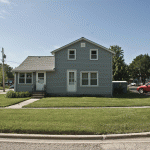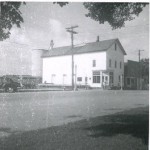HUNTLEY – Regardless of their taste for espresso, many customers likely got a buzz upon seeing the northern wall of Huntley’s freshly opened Starbucks along Route 47.
There, set in against old barn wood – likely of Wisconsin origin, hang historic pictures of Huntley.
More than just a decision of decor, the interior of Starbucks is symbolic of a compromise the village must soon consider: how to balance its renewed growth with the preservation of its past.
Huntley appears to be rising from a recession-induced hibernation. The village’s population exploded from 4,000 in 1999 to 23,000 in 2008. Then, in sync with the nation’s economic woes, Huntley’s growth stalled, the population slowly rising to 24,400 in 2011.
Though a repeat of the “boom years” is not anticipated, Huntley is on the verge of starting or completing several large projects that aim to bring new families, revenue, and jobs to the village. The completion of the $60 million interchange project at Route 47 and I-90 this fall is expected to draw not only travelers, but developers to the I-90 corridor.
The groundbreaking of Centegra Hospital is scheduled for this fall with plans to begin treating patients in 2016 and employ 1,100 local residents. More medical development is set to sprout near Sun City, with a 128-bed Deerpath rehabilitative facility opening this fall and Alden Network’s 14-acre senior living campus currently up for approval by the Village Board.
Huntley High School is wrapping up renovation work on its athletic fields and will begin reworking its hallways and classrooms to accommodate more students. Even St. Mary’s Catholic Church has grown, having added an $8 million addition this spring.
While much of the growth is already in swing, there is much to be decided on the future of Huntley’s downtown area. On Jan. 10, the village board approved a tax increment financing district to provide funding for redevelopment of an area that stretches from Deicke Park to Sponsor’s Bar and Grill.
The TIF is meant to provide aid for redeveloping the downtown square area to attract new private investment. For the downtown, this specifically means rehabilitation of infrastructure and buildings, improving the look of the downtown through streetscape, signage, and facade improvements, and making the area conducive to new property development.

The mill, as it stands today. The building was purchased by the Village of Huntley in August 2012. No plans have been made on what to do with the building as of now. (Mason Souza/Sun Day Photo)
In the past year, the Village has purchased three historic parcels of land near downtown Huntley. The first was the Sawyer-Kelley Mill building, located at 11801 Main St., purchased in August 2012.
Built circa 1890, the mill was first owned by W.G. Sawyer and John T. Kelley. Sawyer was the owner of Star Manufacturing, now owned by Otto Engineering of Carpentersville. After the mill closed, the building housed the village’s post office.
Huntley’s Village Manager Dave Johnson said the village has no definite plans for the building yet but with the village board’s approval may put together proposals for the building to see if there is private interest in its redevelopment.
Jake Marino, board member of the Huntley Historical Society and Huntley Historic Preservation Committee, said the mill building could be “a perfect draw to the downtown.” His ideas for repurposing the building include removing its aluminum siding to reveal its original clampboard siding and possibly adding an elevator and mural along the side that faces Route 47.

The house at 11879 Main St. was purchased by the Village of Huntley this April. The building operated as a hotel during Huntley’s early days. (Mason Souza/Sun Day Photo)
This April, the Village purchased two more historic buildings in town. One, located at 11879 Main St., was purchased from Glen and Laura Lindsey for $170,000.
The building, located near the mill at the corner of Route 47 and Main St., also dates back to about 1890. In its heyday, it served as a hotel, run by the Hackett and later the Sigrist family.
“Right now the desire is to make sure that that is a focal point of the downtown,” Johnson said of the property.
What purpose the building will serve has yet to be determined, but work has already begun on the property, including the razing of the blue metal pole barn that stood next to the home.
The other building purchased in April is located at 11705 First St. and was bought for $88,000 from the estate of Paul and Eva Isenhart. It is likely the oldest of the three: Marino estimates it dates back to the mid-1800s.
Johnson called the home “representative of our history” and said the village will likely seek a new renter to move in.
In addition to buildings, the village purchased three vacant parcels of land behind Village Inn this May. The parcels are adjacent to a parking lot.
Marino was cautious to use the downtown developments of other local communities as a forecast for Huntley. He said Huntley is a different case from its larger neighbors along the Fox River, like East Dundee, West Dundee, Elgin, and St. Charles.

The house at 11705 First St. was also purchased by the Village this April. It is
estimated that the house dates back to the mid-1800s. (Mason Souza/Sun Day Photo)
“The biggest thing that I hear is people say Huntley doesn’t have those kinds of buildings; it’s not that town,” he said. “That’s kind of the point; we don’t have all that much of that. We have maybe one or two examples, which is why it’s best to try to preserve what we do have, try to keep the identity of what this town has been.”
On the Historical Society’s role in shaping the Sawyer Kelley mill’s future, Marino said education and awareness are their points of focus.
Donna Britton, chairperson of the Huntley Historical Preservation Commission, said that although she hopes to see history preserved, she is excited to see the village grow.
“As a resident I’m here and I’m impacted by the growth or non-growth of Huntley, so it’s good that we’re prosperous,” she said.





